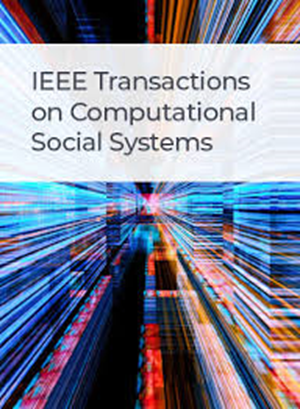利用去噪扩散进行反事实数据扩增以实现图形异常检测
IF 4.5
2区 计算机科学
Q1 COMPUTER SCIENCE, CYBERNETICS
IEEE Transactions on Computational Social Systems
Pub Date : 2024-07-02
DOI:10.1109/tcss.2024.3403503
引用次数: 0
摘要
图神经网络(GNN)的一个重要方面是通过聚合节点邻域信息来增强节点表示。然而,在检测异常时,异常节点的表征很容易被正常邻域平均化,从而使学习到的异常表征区分度降低。为了解决这个问题,我们提出了 CAGAD(一种用于图异常检测的无监督反事实数据增强方法),该方法引入了图指针神经网络作为异嗜节点检测器,以识别邻域以正常节点为主的潜在异常点。对于识别出的每个潜在异常点,我们都会设计一个特定的图扩散模型,将其部分可能正常的邻域转化为异常邻域。最后,我们将这些翻译后的邻域纳入 GNN 邻域聚合中,以产生反事实的异常表示。通过聚合翻译后的异常邻域,反事实表征变得更容易区分,从而进一步提高了检测性能。四个数据集的实验结果表明,CAGAD 的性能明显优于强基线,F1 平均提高 2.35%,AUC-ROC 平均提高 2.53%,AUC-PR 平均提高 2.79%。本文章由计算机程序翻译,如有差异,请以英文原文为准。
Counterfactual Data Augmentation With Denoising Diffusion for Graph Anomaly Detection
A critical aspect of Graph Neural Networks (GNNs) is to enhance the node representations by aggregating node neighborhood information. However, when detecting anomalies, the representations of abnormal nodes are prone to be averaged by normal neighbors, making the learned anomaly representations less distinguishable. To tackle this issue, we propose CAGAD -- an unsupervised Counterfactual data Augmentation method for Graph Anomaly Detection -- which introduces a graph pointer neural network as the heterophilic node detector to identify potential anomalies whose neighborhoods are normal-node-dominant. For each identified potential anomaly, we design a graph-specific diffusion model to translate a part of its neighbors, which are probably normal, into anomalous ones. At last, we involve these translated neighbors in GNN neighborhood aggregation to produce counterfactual representations of anomalies. Through aggregating the translated anomalous neighbors, counterfactual representations become more distinguishable and further advocate detection performance. The experimental results on four datasets demonstrate that CAGAD significantly outperforms strong baselines, with an average improvement of 2.35% on F1, 2.53% on AUC-ROC, and 2.79% on AUC-PR.
求助全文
通过发布文献求助,成功后即可免费获取论文全文。
去求助
来源期刊

IEEE Transactions on Computational Social Systems
Social Sciences-Social Sciences (miscellaneous)
CiteScore
10.00
自引率
20.00%
发文量
316
期刊介绍:
IEEE Transactions on Computational Social Systems focuses on such topics as modeling, simulation, analysis and understanding of social systems from the quantitative and/or computational perspective. "Systems" include man-man, man-machine and machine-machine organizations and adversarial situations as well as social media structures and their dynamics. More specifically, the proposed transactions publishes articles on modeling the dynamics of social systems, methodologies for incorporating and representing socio-cultural and behavioral aspects in computational modeling, analysis of social system behavior and structure, and paradigms for social systems modeling and simulation. The journal also features articles on social network dynamics, social intelligence and cognition, social systems design and architectures, socio-cultural modeling and representation, and computational behavior modeling, and their applications.
 求助内容:
求助内容: 应助结果提醒方式:
应助结果提醒方式:


